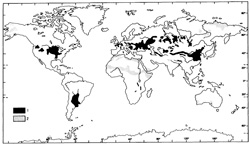- Home
- Science Introduction
- Former Initiatives and Working Groups
- ADOM Scientific Goals
ADOM scientific goals

Overarching Question
What can we learn from eolian records of the last glacial cycle about the dynamics and variability of large-scale atmospheric circulation?
Background
Records from eolian deposits consistently suggest that atmospheric dynamics were highly variable during the last glacial cycle, resulting in alternating periods of extremely dusty to non-dusty conditions, on timescales of millennia and shorter. Yet records differ considerably from different regions, archives and proxies. The strong atmospheric variations during the last glacial interval provide good test cases for how well we understand atmospheric circulation on all levels of conceptual and numerical modeling. However, this requires good knowledge of the patterns of prevailing atmospheric paleocirculation on various regional scales, as well as timing of atmospheric variability relative to other parameters of climatic and environmental change.
The ADOM Working Group aimed to combine eolian-based circulation reconstructions from terrestrial, marine and ice records—in addition to model simulations of past and present atmospheric circulation—to produce detailed knowledge of the processes driving atmospheric dynamics at the regional to hemispheric scale. This knowledge would eventually be upscaled to understand global atmospheric teleconnections.
ADOM aims to publish results in peer-reviewed articles and special journal issues, provide database access to data and model simulations, and quantify the past climate forcing from mineral dust aerosols (with PAGES Focus 1 and with QUEST-Dust).
The goals of ADOM will be pursued through four workshops:
A first workshop will focus on the mid to high-latitude circulation in the northern hemisphere where Loess records from North America, Europe and Asia, and dust records from Greenland, the North Atlantic and the North Pacific provide a comprehensive database. The workshop will explore strategies to derive quantitative and physically consistent synoptic reconstructions by integration of dust-records, climate observations and model simulations.
At two other regional workshops, the developed strategies will then be applied to the low latitudes and to the southern hemisphere.
A final workshop will synthesise results on a global scale.